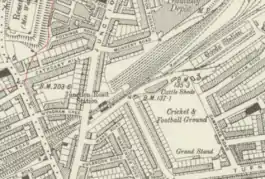Junction Road railway station
Junction Road railway station (originally Junction Road for Tufnell Park) was a railway station in London (1872-1943). The station was opened by the Tottenham & Hampstead Junction Railway.
| Junction Road | |
|---|---|
 | |
| Location | Tufnell Park |
| Local authority | London Borough of Islington |
| Owner | Tottenham & Hampstead Junction Railway |
| Number of platforms | 2 |
| Key dates | |
| 1 January 1872 | Opened |
| 3 May 1943 | Closed |
| Other information | |
It was at the corner of Junction Road and its purpose-built spur, Station Road, in N19 between the districts of Dartmouth Park and Tufnell Park then in the tapering north of the old parish of Islington, resembling the borough today, almost within the Highbury part of Camden (to the west).
It comprised two wooden platforms, accessed by means of a footbridge and stairs, and also served the nearby Tufnell Park goods depot.
Trains from the station generally ran between St Pancras or Kentish Town to Barking or Southend; however, over its history trains ran to a number of other locations including Cambridge, Chingford and Victoria.

It was initially very heavily used, mainly owing to the nearby Metropolitan Cattle Market; at its peak, it was used in 1902 by over 140,000 passengers. When the nearby Tufnell Park Underground station was opened on the Charing Cross, Euston and Hampstead Railway (now the Northern line), passenger levels dropped drastically; in a 1937 poem, John Betjeman set a dark poetic lament at "this lonely station".[1] The station was closed on 3 May 1943 and demolished in the early 1950s; the only remaining evidence of the station are the name "Station Road" and the old Station Master's House on Junction Road.
The Gospel Oak to Barking Line is the name for the current, longer line. Calls for this station to be rebuilt, offering an interchange with the Northern line were amassed and presented in 2013. The Mayor of London and Transport for London jointly replied in a standard response to unfunded proposals to non-needy areas in public transport. They had no plans to do so; they will keep the possibility under review.[2]
References
- Suicide on Junction Road Station after Abstention from Evening Communion in North London in John Betjeman Collected Poems 2006 editions, John Murray (Publishers); featured in other editions
- "Mayor answers to London: Junction Road station". London Assembly. London Assembly. Archived from the original on 4 October 2015. Retrieved 27 March 2015.
| Preceding station | Disused railways | Following station | ||
|---|---|---|---|---|
| Highgate Road (High Level) towards Gospel Oak or Kentish Town |
Tottenham & Hampstead Junction Railway | Upper Holloway towards Barking | ||
| Highgate Road (Low Level) towards Haverstock Hill or Kentish Town |
